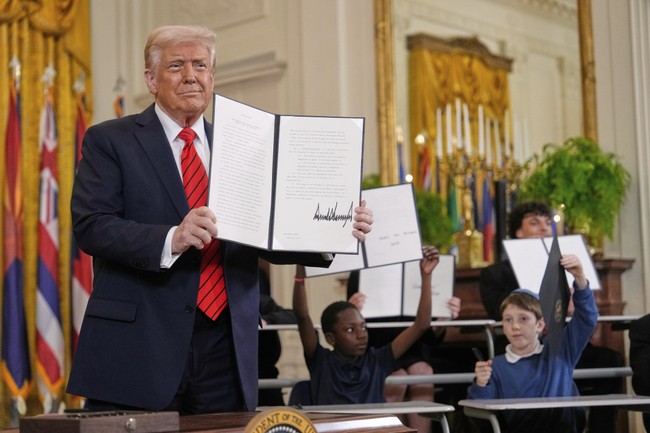
Donald Trump’s war with higher education escalated this week with a series of moves, including an executive order threatening to upend accreditation for Academia. Trump also continued to escalate demand on Harvard specifically, letting other universities know that the White House means business with its enforcement of the Civil Rights Act under its new interpretations. That also holds the promise of opening up private actions through the False Claims Act that could dismantle the financial models of universities and colleges.
Those are big guns indeed. However, another EO taking aim at compulsory education may have deeper and longer-lasting impact on American education, yet it didn’t attract much notice. Prosaically entitled “Reinstating Common Sense School Discipline Policies,” the order reverses decades of encroaching federal restrictions on disciplinary actions by teachers and schools that have led to chaos in classrooms and undermined real education.
It explicitly reverses a 2014 “Dear Colleague” joint letter from Barack Obama’s Departments of Education and Justice that demanded schools apply a “disparate-impact framework” to school discipline on the basis of race. Some school districts had already adopted such policies years earlier, but the 2014 instruction forced the rest to adopt them. They created such a difficult environment for enforcement that schools erred on the side of avoiding disciplinary action altogether — turning classrooms into nightmares for teachers and students.
As the EO notes, it didn’t take long for everyone to figure that out:
The consequences harmed students and schools. A 2018 report from the Federal Commission on School Safety (Commission) noted evidence that, because of the 2014 letter, “schools ignored or covered up — rather than disciplined — student misconduct in order to avoid any purported racial disparity in discipline numbers that might catch the eye of the federal government.” As a result, students who should have been suspended or expelled for dangerous behavior remained in the classroom, making all students less safe.
As the Commission found: “When school leaders focus on aggregate school discipline numbers rather than the specific circumstances and conduct that underlie each matter, schools become less safe,” and “[r]esearch clearly indicates that the failure of schools to appropriately discipline disruptive students has consequences for overall student achievement.” The Commission’s seemingly obvious conclusion was that “disciplinary decisions are best left in the hands of classroom teachers and administrators” and should be based on student behavior, rather than racial statistics.
At that time, Trump rescinded the 2014 policy, but didn’t apparently take any steps to enforce better policies on schools that still adhered to the “disparate-impact framework.” Joe Biden reinstated the 2014 policy in 2023, which resulted in “teachers and students … suffering increased levels of classroom disorder and school violence.”
This time, Trump is not just rescinding the 2014/2023 ‘guidance,’ but plans to enforce its own version of school discipline policies to restore order in classrooms, emphasis mine:
(a) Within 30 days of the date of this order, the Secretary of Education, in consultation with the Attorney General, shall issue new guidance to local educational agencies (LEAs) and State educational agencies (SEAs) regarding school discipline and their obligations not to engage in racial discrimination under Title VI in all contexts, including school discipline.
(b) The Secretary of Education shall take appropriate action with respect to LEAs and SEAs that fail to comply with Title VI protections against racial discrimination in the application of school discipline.
(c) Within 60 days of the date of this order, the Secretary of Education and the Attorney General shall initiate coordination with Governors and State Attorneys General regarding the prevention of racial discrimination in the application of school discipline.
(d) Within 90 days of the date of this order, the Secretary of Defense shall issue a revised school discipline code that appropriately protects and enhances the education of the children of America’s military-service families.
(e) Within 120 days of the date of this order, the Secretary of Education shall, in coordination with the Attorney General, the Secretary of Health and Human Services, and the Secretary of Homeland Security, submit a report to the President, through the Assistant to the President for Domestic Policy, regarding the status of discriminatory-equity-ideology-based school discipline and behavior modification techniques in American public education .
Education Secretary Linda McMahon promised to take the handcuffs off of teachers and administrators to restore classroom discipline:
McMahon said the order and forthcoming guidance will give “teachers the authority now to have discipline in their classroom and discipline the person who is being disruptive.”
Within six months, McMahon in coordination with other federal leaders must submit a report to the president on “discriminatory-equity-ideology-based school discipline and behavior modification techniques in American public education” since 2009.
In her statement, McMahon said, “A student’s success in adulthood starts with how they perform in a classroom, and we should teach our kids to discern right and wrong from a young age.” She said schools have been “forced to consider equity and inclusion when imposing discipline.”
Even though this didn’t get much attention from the media, it could be a gamechanger — especially for teachers, who have been fleeing classrooms at a higher rate over the last decade. A new survey published yesterday in Missouri by its teachers union shows that nearly three-quarters of its members considered quitting or retiring in the previous year. And guess why?
According to the survey, 71% of teachers wanted to quit in 2025 compared to 70% of teachers in 2024. More than one-third of the surveyed teachers said the 2024-2025 school year was more stressful than last year.
The survey was sent to all of the MSTA’s 1,800 members, including teachers, administrators, and non-certified members. The questionnaire evaluated job satisfaction, pain points, what is working well, and suggestions on how to improve public education.
“Student behavior continues to be one of the main concerns for teachers,” the survey stated.
When the inmates run the asylum, what incentives are there for the orderlies?
Regaining control of classrooms will mean teachers will stick around. That means greater continuity for students. More importantly, it means that disruptors will get removed rather than remain to impede the education of others. Hopefully, the new policies will restore the use of expulsions as a disciplinary device to ensure that repeat disruptors get removed from the educational environment and force their families to deal with the problems themselves rather than pass them onto the schools.
This reform may have the most potential to improve education in primary and secondary education. That alone will help performance in higher education, and if tied with curricula reform that disposes of cultural-Marxist indoctrination in favor of real fundamentals of education, American education can start improving exponentially. Classroom discipline is a good place to start.







